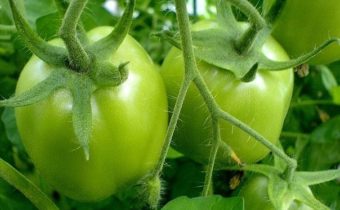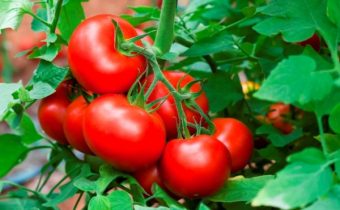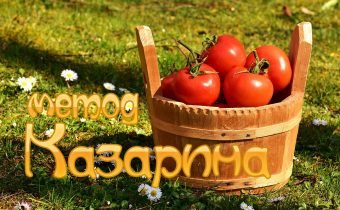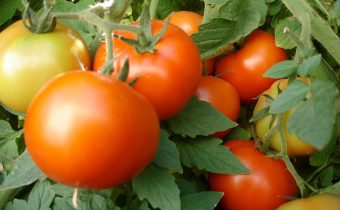How to deal with brown spot on tomatoes in a greenhouse
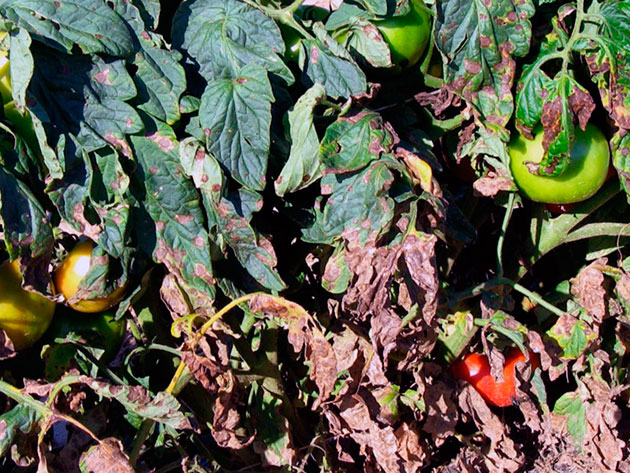
Brown spotting is a common disease of greenhouse tomatoes that can kill up to 80% of the crop. It occurs at high humidity and high temperature. This is not surprising, because kladosporiosis (the scientific name of the disease) is a fungal infection.
What is klaosporiosis
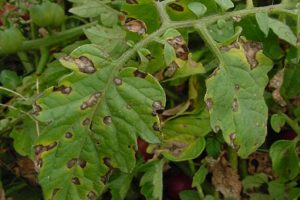
The causative agent of the infection is a fungus called Cladosporium fulvum Cooke (from this the name of the disease). When fungal conidia get on the leaves, the plant becomes infected. Conidia are located directly on the forming mycelium, and not in a special organ that other species of fungi have. Conidia are light, small. Outwardly, they look like dust particles. Conidia spread with lightning speed through wind and moisture, as well as through infected garden tools.
Fungal spores can live for many years in the soil, on plant residues, the greenhouse frame, and seeds. They are not taken either by prolonged cold or by many days of drought. The peculiarities of conidia are that they multiply asexually, they can live for a long time without a host plant, and the viability of a dispute lasts for about a year.
Scientists believe that spores of the kladosporia (the causative agent of brown spot) are the most ancient fungal organism. It was discovered at kilometer-long oceanic depth.
Causes of the disease
The greenhouse climate is an ideal habitat for the fungus. Getting into the greenhouse, the fungus is quickly localized to weakened plants, waiting for the most suitable conditions for reproduction. Usually they come in the middle of June, when it becomes quite hot outside, and the air in the greenhouse is very hot. With improper watering, poor ventilation and thick planting tomatoes moisture evaporates for a long time, condensation forms. In most of the plantations water accumulates, the leaves and stems themselves are constantly wet. All this has the best effect on the rapidly increasing activity of conidia. When the air humidity reaches 90% and the temperature is above 25 degrees, the fungus proceeds with rapid reproduction.
The causative agent of the disease is transferred to plants by watering or light wind blowing.
Symptoms of the disease
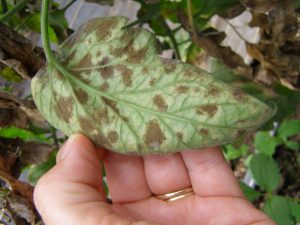
Usually, an outbreak of cladosporia is observed in the middle of the vegetative development of tomato bushes, during flowering and the formation of fruit ovaries. First, the disease affects the lower part of the bush. Very quickly, the fungus gets to the apical organs of the bush, all the leaves are already affected.
The main signs of brown spot:
- In the lower leaflets, the outer side of the leaf plates is covered with yellow-green, dirty spots of various sizes and shapes. Then their color becomes brown, brown with a yellow border.
- On the back of the leaves on the spots that appear, you can see a whitish "terry" patina of light green, olive color. Over time, this color changes to brown, gradually reaching almost black - a sign of maturation of the fungus spores.
Developing, the disease affects not only the foliage, but also flowers, petioles, ovaries. They also appear ugly brownish-yellow stains, which over time becomes visible sporosheniya fungus plaque.
Without treatment, diseased leaves dry out, their structure, shape, elasticity, color change. A couple of weeks after the manifestation of a painful spore, the foliage completely dies and falls. When leaves fall, the process of photosynthesis is disturbed, which leads to the gradual death of the whole plant.
The disease usually does not affect the fruits and stems, but they die off by themselves due to a lack of nutrients. True, only small tomatoes can quickly become covered with spores, which quickly turn brown, shrivel and fall off.
Cladosporiosis treatment
Unfortunately, it is impossible to completely overcome the brown spot, even if you find the disease in time. Spores of the fungus spread so quickly that it is almost impossible to stop them in conditions of hot summer and excessive humidity in the greenhouse space. Therefore, all treatment is usually reduced to inhibition of the development of the disease in order to have time to save at least part of the crop. And with the course of the disease started, it is impossible to even stop the rapidly growing colony of conidia. Control measures are reduced to regular inspection of plantations, preventive spraying. If the disease has just manifested itself, then gardeners usually experience traditional methods of treatment, and only then proceed to chemical poisons.
Folk methods of combating cladosporia
Experienced gardeners can quickly detect the occurrence of a malicious ailment on their tomatoes. If kladosporiosis is noticed in time, then there is every chance to overcome the disease with the help of folk remedies that are harmless to the plants.
Effective recipes:
- at the initial change in the structure of leaves, tomatoes are sprayed with iodine chloride. In order to maximize the effect, it is necessary to stir iodine (40-45 drops) and potassium chloride (30 grams) in a bucket of water and to shed the pre-burnt areas under the bushes well. So that the solution gets not only on the plants themselves, but also penetrates deep into the soil, because it is in it that the fungus is hidden.
- Two weeks after planting the seedlings on the garden, the tomatoes are watered with a weakly concentrated solution of potassium permanganate alternately with an ash-water solution. Useful watering is carried out once a week;
- for the healing treatment of tomatoes 0.5 kilograms of peeled garlic cloves are crushed and poured with 10 liters of water. The mixture is infused for 2-3 days. Before use, add 20-3 drops of iodine to the tincture;
- tainted bushes are treated with whey diluted in water in a ratio of 1:10. Instead of whey, you can use regular milk. It is good to add 15 drops of iodine to the mixture.
Chemistry Treatment
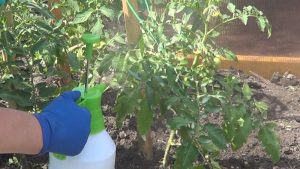
If time is missed, and the brown spot began to “devour” the plants one by one, then there is no point in self-healing using traditional methods. With a severe course of the disease, rehabilitation is possible only with the use of the strongest specialized fungicides. Many gardeners do not favor this method, because the quality of the fruit may suffer. However, sometimes only chemistry can save the crop. And the correct use of drugs (20 days before harvest) will help to avoid the penetration of poisons into the tomatoes.
"Chemical" recipes:
- when brown spot is found, dissolve 3 tablespoons of colloidal sulfur in a glass with copper sulphate and the same amount of polycarbocin. The suspension is thoroughly mixed in a bucket of cold water. Before spraying, liquid or frayed soap is added to the solution so that the product adheres better to the leaves. The resulting mixture is sprayed absolutely all planting (including healthy) every ten days. In case of a minor injury, it is enough to treat the beds 2-3 times over the summer;
- from kladosporiosis will help systematic spraying by special means of a wide focus. For these purposes, copper oxychloride, Bravo, and Ditan NeoTech 75 are offered in stores. They do a good job with the infection Azofos, Abika-pik. These funds can only be used before the formation of fruits;
- From a number of diseases, including kladosporiosis, directed fungicides such as Hom, Polyhim, Poliram, Zineb, Kaptan are intended to help. Diluted according to the instruction means spray the tomatoes twice at two-week intervals;
- for large lesions, tomatoes are sprayed with Fitolavin. This preparation is processed 2 times since the detection of the disease;
- Of the biological agents, Pseudobacterin-2, Strobe, and Fitosporin have recommended themselves well. By the way, they are struggling not only with brown spot, but also with many other infectious diseases. At the same time, these drugs are practically harmless to humans and plants.
Prevention
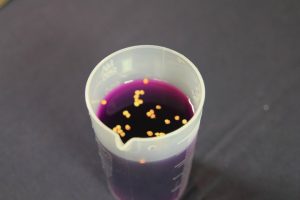
It has been proven by many years of experience that compliance with preventive measures dramatically increases the chances of growing strong seedlings and getting a good harvest. Measures to combat cladosporia apply even seed sowing. Remember that the spores of the fungus can lie on their surface, and therefore before the sowing procedure, all the seed material must undergo disinfection with the help of potassium permanganate or calcination.
Further apply the following measures:
- Annually the place of cultivation of tomatoes needs to be changed. You can return to the old bed in 3-4 years. Tomatoes should not be planted where other solanaceous plants had previously grown;
The fungus can live in the depths of the soil for more than three years!
- Filling up a bed, the soil is watered with Fitosporin's solution. In the future, this tool is added to water with irrigation of tomatoes at least 2-3 times with an interval of 14 days.
- Tomatoes are fed with strengthening fertilizers throughout the growing season.
- Significantly reduce the chances of the appearance of the disease will help control the level of moisture in the greenhouse. Relative humidity should be between 60-65%.
- On one square meter planted 4-5 young seedlings of seedlings. With such a planting scheme, adult plants will be well ventilated, which means that the moisture will evaporate better.
- Watering is best done rarely, but plentifully. So as not to accumulate condensate, after irrigation arrange ventilation.
- To reduce the amount of watering can be done by mulching the earth with straw or peat. You can also cover the surface with black film, which will delay evaporation, which means that the moisture level will remain optimal.
- The temperature in the greenhouse often fluctuates. To maintain the degree in the desired values (+ 20-22 degrees) will help good ventilation, protective awning, stretched over the greenhouse, containers with cold water. It should also prevent sudden fluctuations in day and night temperatures. To do this, it is necessary to take measures to increase the heat at night - install radiators or close the doors and windows of the greenhouse tightly.
- After harvesting, it is necessary to thoroughly clean the land from crop residues and weeds. They should be taken out of the greenhouse and burned.
- To prevent the risk of developing diseases, the frame and walls of the greenhouse are disinfected twice a year with copper sulphate, Bordeaux mixture, hydrated lime, manganese concentrate, etc.
- In regions where tomato lesions are often observed with brown spot, it is recommended to use varieties resistant to this type of disease for growing.
Disease resistant varieties
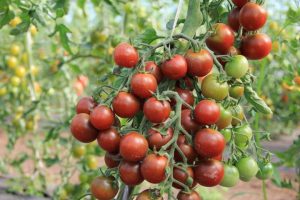
Today, there are many varieties, in particular, hybridswhich are less likely to be affected by brown spot. Therefore, if there is no confidence in the quality of the soil and the normal conditions of the maintenance of tomatoes, it is recommended to select for cultivation just hardy and immunoprotected varieties of tomatoes.
Recommended varieties:
- Our Masha F1 and varieties derived from it (Titanic, Centaur, Victoria, Red Comet, etc.);
- Torbay;
- Start;
- Spartacus;
- Bohemia;
- Vologda;
- Funtik;
- Paradisaic delight;
- Red cherry;
- Vezha;
- Gardener;
- Delicacy;
- Space star;
- Admiralty.
All these hybrids and varieties are distinguished by large and juicy fruits and unsurpassed health of tomato plants. They can even bear fruit tolerably well even on scanty land and under adverse climatic conditions.
Tips experienced gardeners
Every year, tireless gardeners come up with their methods of dealing with fungal disease. Unfortunately, a universal remedy has not yet been invented for getting rid of the misfortune; however, a combination of several methods of dealing with spotting at once can give their results. So, what do experienced gardeners advise:
- once a year in the greenhouse use sulfuric smoke bomb. The smell, though frightening, however, from cladosporia, as well as many pests, will not remain a trace;
- in winter, it is recommended to remove the walls of the greenhouse completely so that during the three winter months the ground is thoroughly frozen;
- Tomatoes, regardless of the variety in the greenhouse, are better to be kept in 1-2 stems. Lower foliage and asexual branches must be removed. Thickened areas should be thinned;
- Tomato bushes with the appearance of the first signs of cladosporia can be sprayed with ordinary soapy water, and then wash the bushes with water by sprinkling; After washing, good ventilation is performed to completely dry the foliage.
- The best orderly for the soil is winter rye. It must be sown a year before planting tomatoes and leave until spring. Before planting seedlings rye pruned at the root, but not dug. Tomatoes are planted right along with rye.
Where there is cladosporia, there is no late blight. These diseases are incompatible.
Conclusion
Brown spot dramatically reduces yield, destroying not only tomatoes, but also other vegetable crops. Only constant prevention and the use of popular methods will help reduce the chances of the appearance of the disease in your garden. If the leaves have become covered with brown spots, then it is more rational not to waste time, and then to use chemical agents, most of which do an excellent job with cladosporia at the initial stage.



